belt Lexus CT200h 2012 (in English) Owner's Guide
[x] Cancel search | Manufacturer: LEXUS, Model Year: 2012, Model line: CT200h, Model: Lexus CT200h 2012Pages: 710
Page 153 of 710
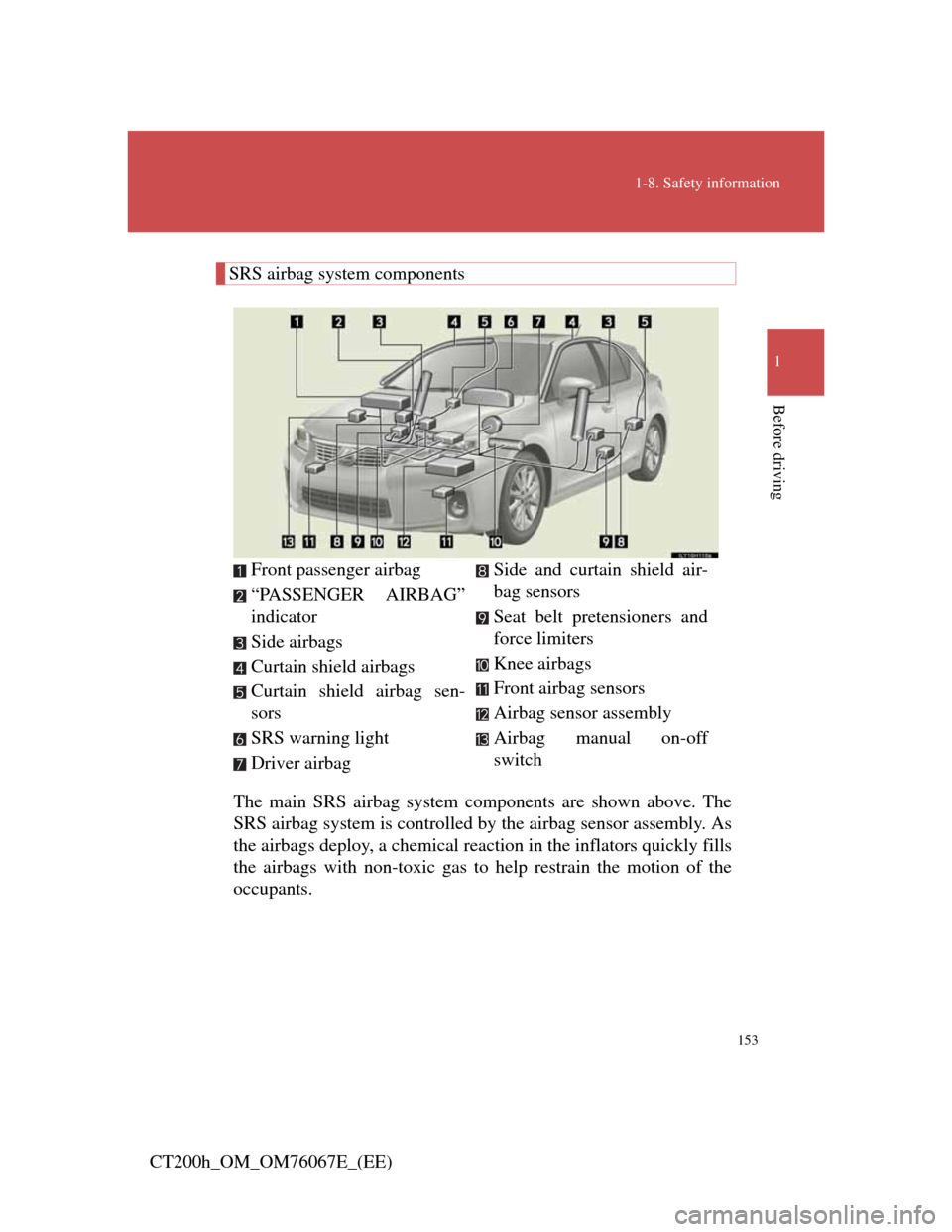
153
1-8. Safety information
1
Before driving
CT200h_OM_OM76067E_(EE)
SRS airbag system components
The main SRS airbag system components are shown above. The
SRS airbag system is controlled by the airbag sensor assembly. As
the airbags deploy, a chemical reaction in the inflators quickly fills
the airbags with non-toxic gas to help restrain the motion of the
occupants.Front passenger airbag
“PASSENGER AIRBAG”
indicator
Side airbags
Curtain shield airbags
Curtain shield airbag sen-
sors
SRS warning light
Driver airbagSide and curtain shield air-
bag sensors
Seat belt pretensioners and
force limiters
Knee airbags
Front airbag sensors
Airbag sensor assembly
Airbag manual on-off
switch
Page 154 of 710

154
1-8. Safety information
CT200h_OM_OM76067E_(EE)
If the SRS airbags deploy (inflate)
Bruising and slight abrasions may result from contact with a deploying
(inflating) SRS airbag.
A loud noise and white powder will be emitted.
Parts of the airbag module (steering wheel hub, airbag cover and infla-
tor) as well as the front seats, parts of the front and rear pillars, and roof
side rails, may be hot for several minutes. The airbag itself may also be
hot.
The windshield may crack.
SRS airbag deployment conditions (SRS front airbags)
The SRS front airbags will deploy in the event of an impact that exceeds
the set threshold level (the level of force corresponding to an approxi-
mately 20-30 km/h [12-18 mph] frontal collision with a fixed wall that
does not move or deform).
However, this threshold velocity will be considerably higher if the vehicle
strikes an object, such as a parked vehicle and sign pole, which can move
or deform on impact, or if the vehicle is involved in an underride collision
(e.g. a collision in which the front of the vehicle “underrides”, or goes
under, the bed of a truck, etc.).
Depending on the type of collision, it is possible that only the seatbelt
pretensioners will activate.
SRS airbag deployment conditions (SRS side and curtain shield airbags)
The SRS side and curtain shield airbags will deploy in the event of an
impact that exceeds the set threshold level (the level of force corresponding
to the impact force produced by an approximately 1500 kg [3300 lb.] vehi-
cle colliding with the vehicle cabin from a direction perpendicular to the
vehicle orientation at an approximate speed of 20 -30 km/h [12 -18 mph]).
Page 158 of 710
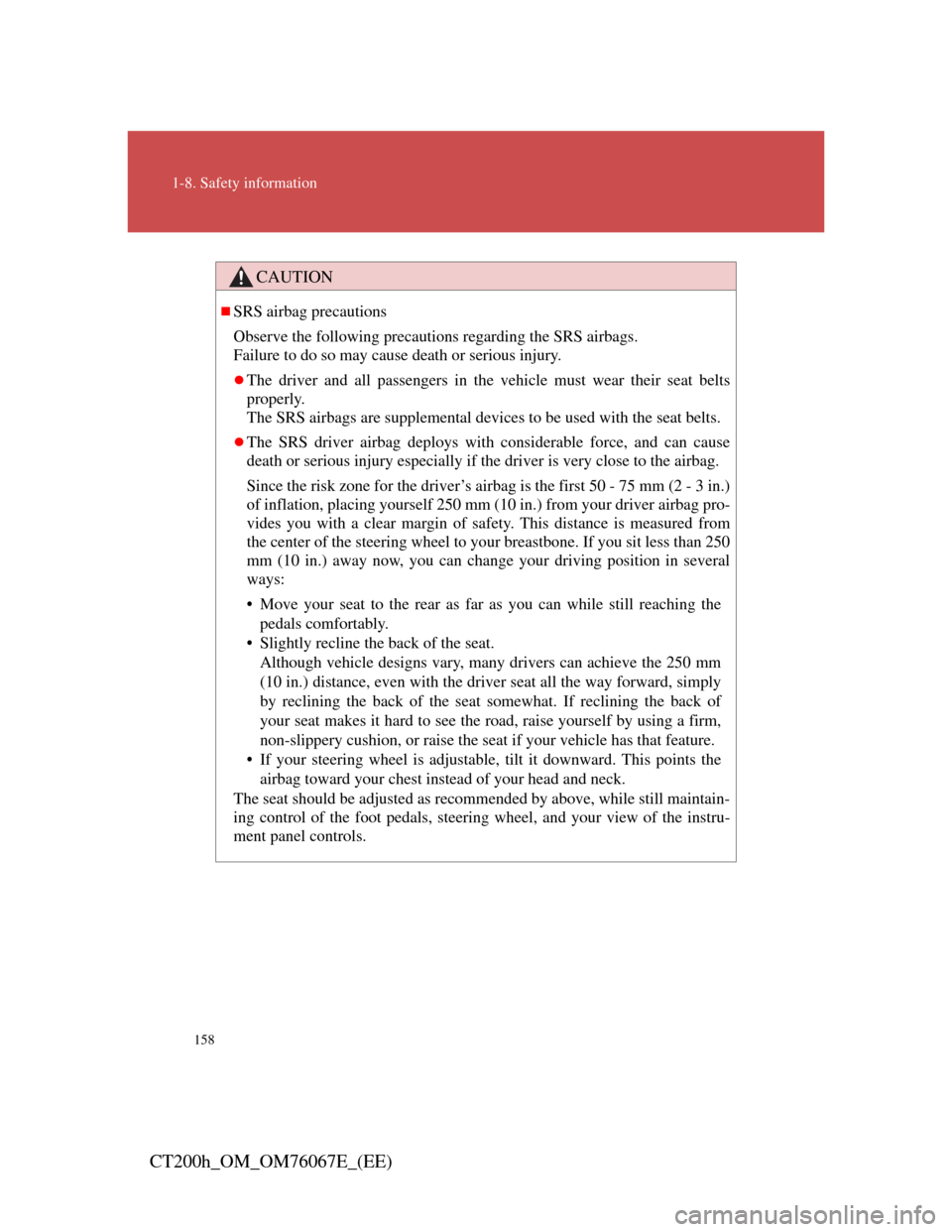
158
1-8. Safety information
CT200h_OM_OM76067E_(EE)
CAUTION
SRS airbag precautions
Observe the following precautions regarding the SRS airbags.
Failure to do so may cause death or serious injury.
The driver and all passengers in the vehicle must wear their seat belts
properly.
The SRS airbags are supplemental devices to be used with the seat belts.
The SRS driver airbag deploys with considerable force, and can cause
death or serious injury especially if the driver is very close to the airbag.
Since the risk zone for the driver’s airbag is the first 50 - 75 mm (2 - 3 in.)
of inflation, placing yourself 250 mm (10 in.) from your driver airbag pro-
vides you with a clear margin of safety. This distance is measured from
the center of the steering wheel to your breastbone. If you sit less than 250
mm (10 in.) away now, you can change your driving position in several
ways:
• Move your seat to the rear as far as you can while still reaching the
pedals comfortably.
• Slightly recline the back of the seat.
Although vehicle designs vary, many drivers can achieve the 250 mm
(10 in.) distance, even with the driver seat all the way forward, simply
by reclining the back of the seat somewhat. If reclining the back of
your seat makes it hard to see the road, raise yourself by using a firm,
non-slippery cushion, or raise the seat if your vehicle has that feature.
• If your steering wheel is adjustable, tilt it downward. This points the
airbag toward your chest instead of your head and neck.
The seat should be adjusted as recommended by above, while still maintain-
ing control of the foot pedals, steering wheel, and your view of the instru-
ment panel controls.
Page 159 of 710
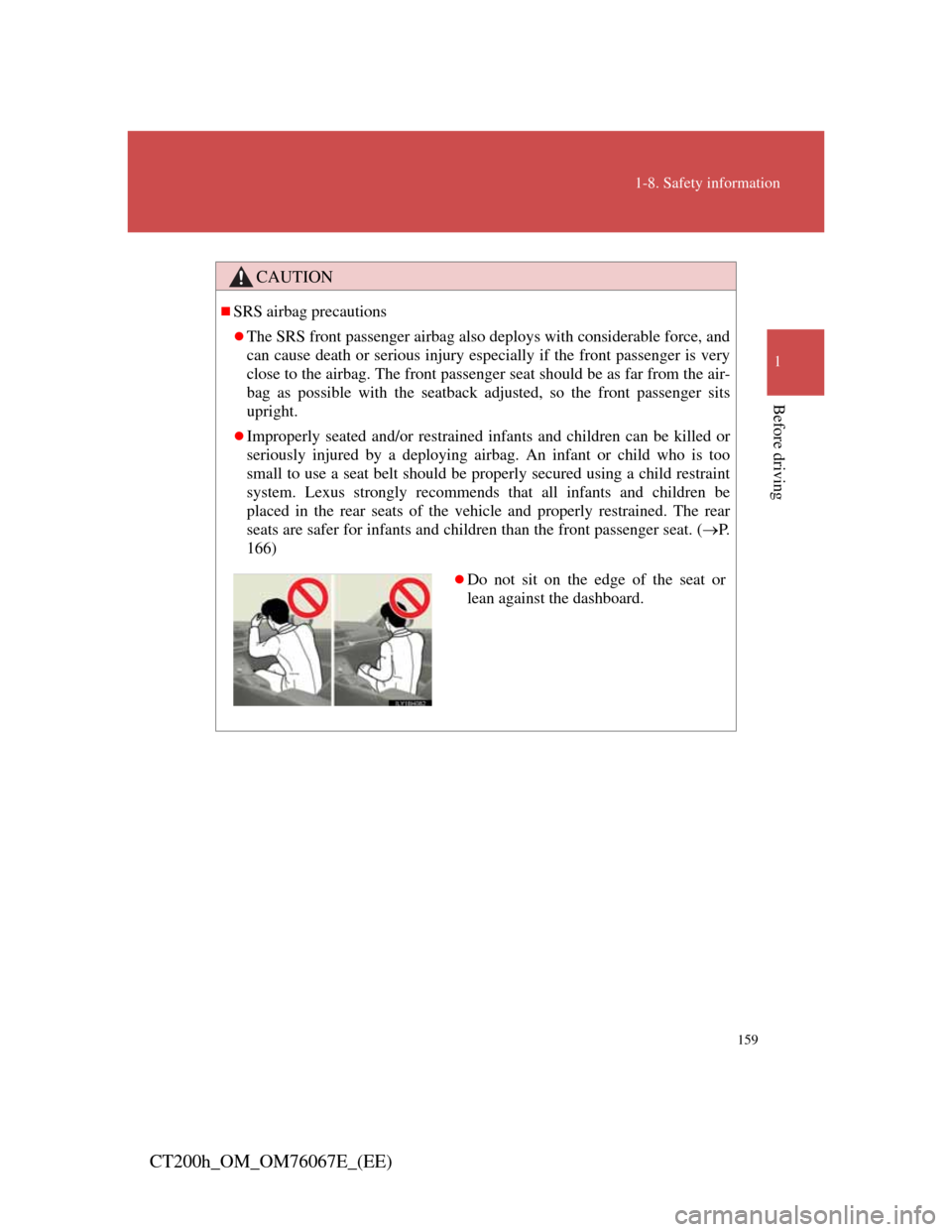
159
1-8. Safety information
1
Before driving
CT200h_OM_OM76067E_(EE)
CAUTION
SRS airbag precautions
The SRS front passenger airbag also deploys with considerable force, and
can cause death or serious injury especially if the front passenger is very
close to the airbag. The front passenger seat should be as far from the air-
bag as possible with the seatback adjusted, so the front passenger sits
upright.
Improperly seated and/or restrained infants and children can be killed or
seriously injured by a deploying airbag. An infant or child who is too
small to use a seat belt should be properly secured using a child restraint
system. Lexus strongly recommends that all infants and children be
placed in the rear seats of the vehicle and properly restrained. The rear
seats are safer for infants and children than the front passenger seat. (P.
166)
Do not sit on the edge of the seat or
lean against the dashboard.
Page 167 of 710
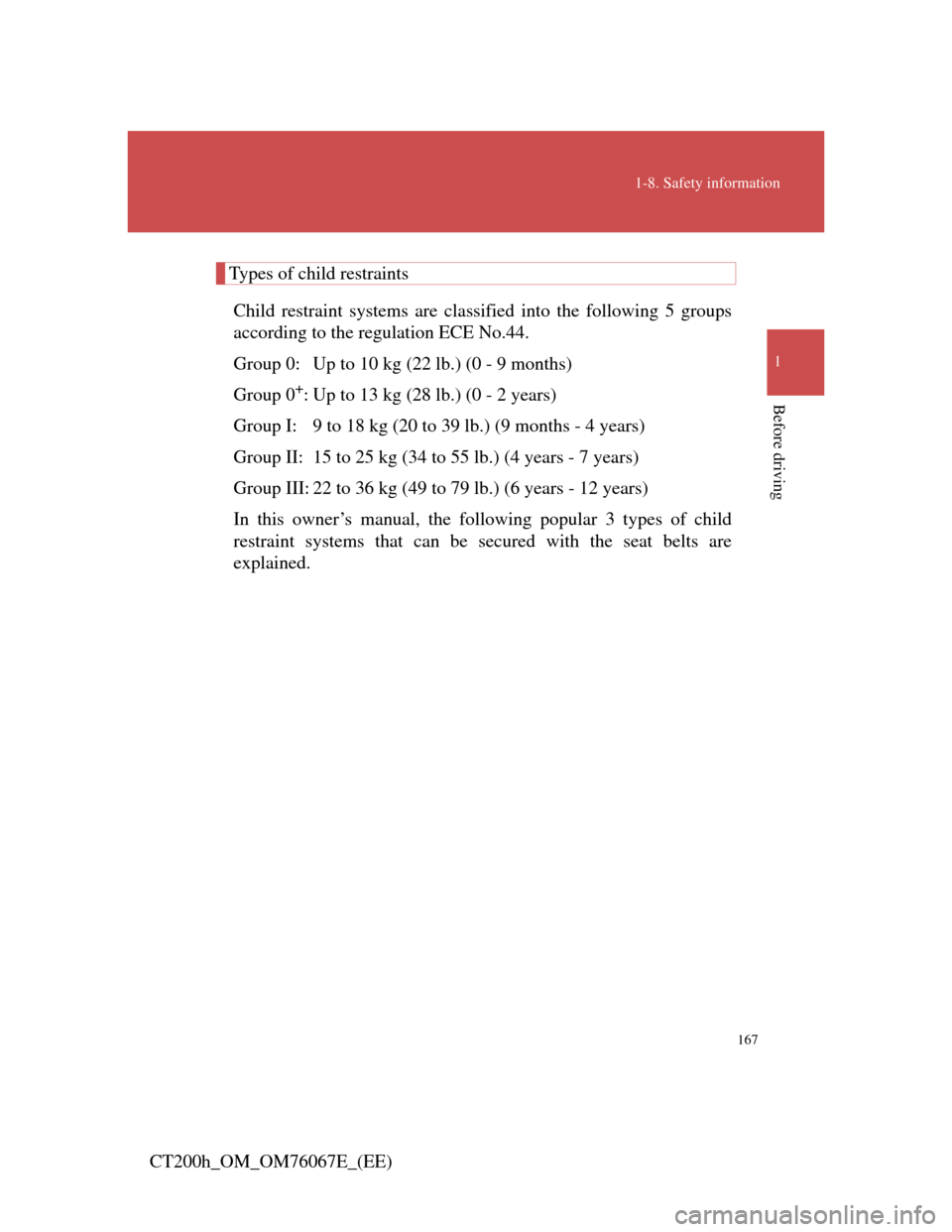
167
1-8. Safety information
1
Before driving
CT200h_OM_OM76067E_(EE)
Types of child restraints
Child restraint systems are classified into the following 5 groups
according to the regulation ECE No.44.
Group 0: Up to 10 kg (22 lb.) (0 - 9 months)
Group 0
+: Up to 13 kg (28 lb.) (0 - 2 years)
Group I: 9 to 18 kg (20 to 39 lb.) (9 months - 4 years)
Group II: 15 to 25 kg (34 to 55 lb.) (4 years - 7 years)
Group III: 22 to 36 kg (49 to 79 lb.) (6 years - 12 years)
In this owner’s manual, the following popular 3 types of child
restraint systems that can be secured with the seat belts are
explained.
Page 170 of 710

170
1-8. Safety information
CT200h_OM_OM76067E_(EE)Key of letters inserted in the above table:
U: Suitable for “universal” category child restraint system
approved for the use in this mass group.
UF: Suitable for forward facing “universal” category child
restraint system approved for the use in this mass group.
L1: Suitable for “LEXUS G 0+, BABY SAFE PLUS” (0 to 13 kg
[0 to 28 lb.]) approved for the use in this mass group.
L2: Suitable for “LEXUS G 0+, BABY SAFE PLUS with SEAT
BELT FIXATION, BASE PLATFORM” (0 to 13 kg [0 to
28 lb.]) approved for the use in this mass group.
L3: Suitable for “LEXUS DUO+” (without ISOFIX, 9 to 18 kg
[20 to 39 lb.]) approved for the use in this mass group.
L4: Suitable for “LEXUS KID” (15 to 36 kg [34 to 79 lb.])
approved for the use in this mass group.
L5: Suitable for “LEXUS KIDFIX” (15 to 36 kg [34 to 79 lb.])
approved for the use in this mass group.
X: Not suitable seat position for children in this mass group.
*1: When you use a child restraint system in this position, adjust
the seat back and fix it at the most upright lock position.
*2: When you use a child restraint system in this position, remove
the head restraint.
Other child restraint system which is different from the system
mentioned in the table can be used.
But the suitability of the systems must be carefully checked with
the child restraint system manufacturer concerned and the seller of
those seats.
Page 173 of 710
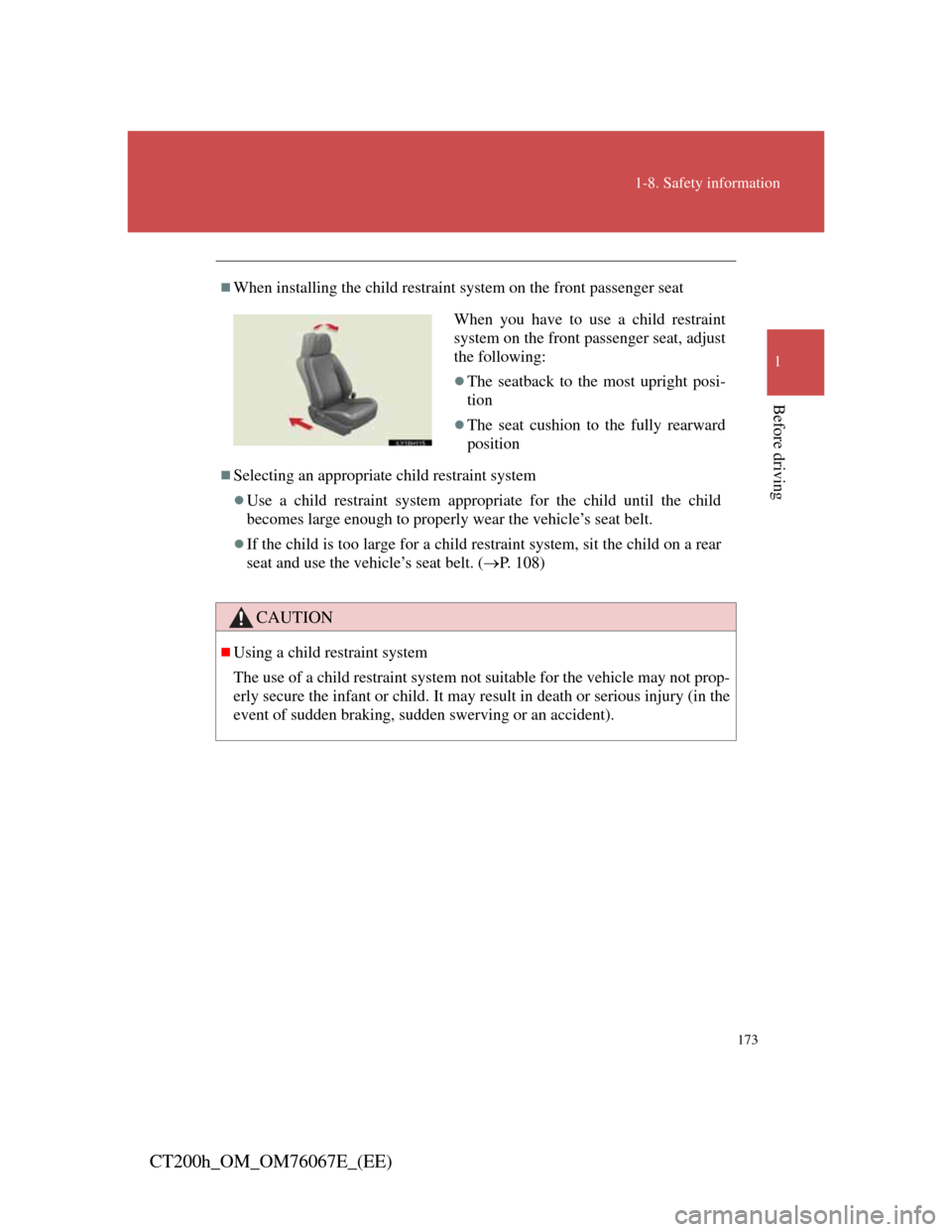
173
1-8. Safety information
1
Before driving
CT200h_OM_OM76067E_(EE)
When installing the child restraint system on the front passenger seat
Selecting an appropriate child restraint system
Use a child restraint system appropriate for the child until the child
becomes large enough to properly wear the vehicle’s seat belt.
If the child is too large for a child restraint system, sit the child on a rear
seat and use the vehicle’s seat belt. (P. 1 0 8 )
CAUTION
Using a child restraint system
The use of a child restraint system not suitable for the vehicle may not prop-
erly secure the infant or child. It may result in death or serious injury (in the
event of sudden braking, sudden swerving or an accident).
When you have to use a child restraint
system on the front passenger seat, adjust
the following:
The seatback to the most upright posi-
tion
The seat cushion to the fully rearward
position
Page 174 of 710

174
1-8. Safety information
CT200h_OM_OM76067E_(EE)
CAUTION
Child restraint precautions
For effective protection in automobile accidents and sudden stops, a child
must be properly restrained, using a seat belt or child restraint system
depending on the age and size of the child. Holding a child in your arms is
not a substitute for a child restraint system. In an accident, the child can be
crushed against the windshield, or between you and the vehicle’s interior.
Lexus strongly urges the use of a proper child restraint system that con-
forms to the size of the child, installed on the rear seat. According to acci-
dent statistics, the child is safer when properly restrained in the rear seat
than in the front seat.
Never install a rear-facing child restraint system on the front passenger
seat when the airbag manual on-off switch is on. (P. 163)
In the event of an accident, the force of the rapid inflation of the front pas-
senger airbag can cause death or serious injury to the child.
A forward-facing child restraint system may be installed on the front pas-
senger seat only when it is unavoidable. A child restraint system that
requires a top strap should not be used in the front passenger seat since
there is no top strap anchor for the front passenger seat. Adjust the seat-
back as upright as possible and always move the seat as far back as possi-
ble because the front passenger airbag could inflate with considerable
speed and force. Otherwise, the child may be killed or seriously injured.
Page 175 of 710

175
1-8. Safety information
1
Before driving
CT200h_OM_OM76067E_(EE)
CAUTION
Child restraint precautions
Do not allow the child to lean his/her head or any part of his/her body
against the door or the area of the seat, front and rear pillars or roof side
rails from which the SRS side airbags or SRS curtain shield airbags
deploy even if the child is seated in the child restraint system. It is danger-
ous if the SRS side airbags and curtain shield airbags inflate, and the
impact could cause death or serious injury to the child.
Make sure you have complied with all installation instructions provided
by the child restraint manufacturer and that the system is properly
secured. If it is not secured properly, it may cause death or serious injury
to the child in the event of a sudden stop, sudden swerve or an accident.
When children are in the vehicle
Do not allow children to play with the seat belt. If the seat belt becomes
twisted around a child’s neck, it may lead to choking or other serious inju-
ries that could result in death.
If this occurs and the buckle cannot be unfastened, scissors should be used
to cut the belt.
When the child restraint system is not in use
Keep the child restraint system properly secured on the seat even if it is
not in use. Do not store the child restraint system unsecured in the passen-
ger compartment.
If it is necessary to detach the child restraint system, remove it from the
vehicle or store it securely in the luggage compartment. This will prevent
it from injuring passengers in the event of a sudden stop, sudden swerve
or accident.
Page 176 of 710

176
1-8. Safety information
CT200h_OM_OM76067E_(EE)
Installing child restraints
Follow the child restraint system manufacturer’s instructions. Firmly
secure child restraints to the seats using a seat belt or ISOFIX rigid
anchors. Attach the top strap when installing a child restraint.
Seat belts (An ELR belt
requires a locking clip.)
ISOFIX rigid anchors (ISO-
FIX child restraint system)
Lower anchors are provided
for the outboard rear seats.
(Buttons displaying the loca-
tion of the anchors are
attached to the seats.)
Anchor brackets (for top
strap)
An anchor bracket is pro-
vided for outboard rear seats.